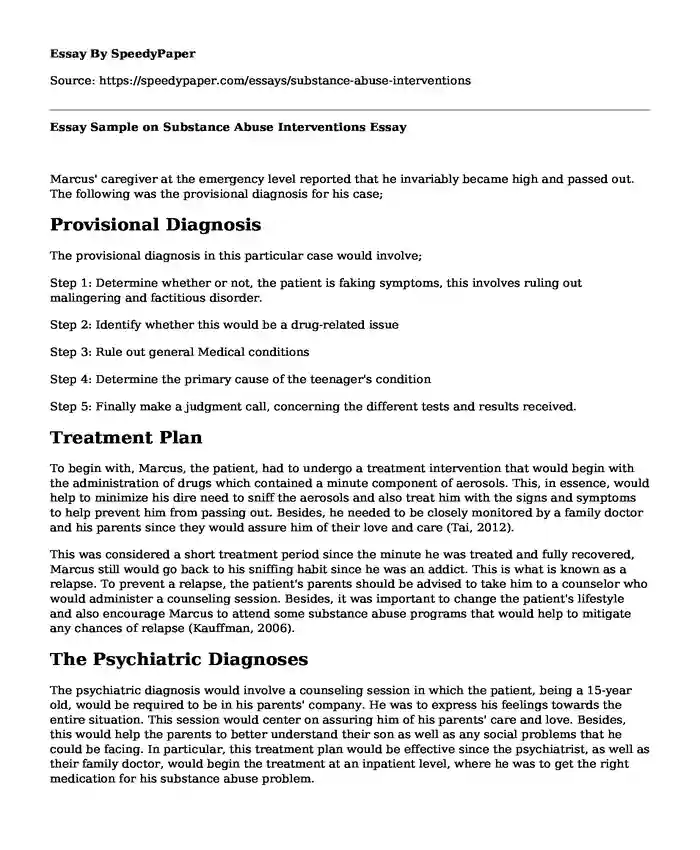
| Type of paper: | Research paper |
| Categories: | Substance abuse |
| Pages: | 3 |
| Wordcount: | 672 words |
Marcus' caregiver at the emergency level reported that he invariably became high and passed out. The following was the provisional diagnosis for his case;
Provisional Diagnosis
The provisional diagnosis in this particular case would involve;
Step 1: Determine whether or not, the patient is faking symptoms, this involves ruling out malingering and factitious disorder.
Step 2: Identify whether this would be a drug-related issue
Step 3: Rule out general Medical conditions
Step 4: Determine the primary cause of the teenager's condition
Step 5: Finally make a judgment call, concerning the different tests and results received.
Treatment Plan
To begin with, Marcus, the patient, had to undergo a treatment intervention that would begin with the administration of drugs which contained a minute component of aerosols. This, in essence, would help to minimize his dire need to sniff the aerosols and also treat him with the signs and symptoms to help prevent him from passing out. Besides, he needed to be closely monitored by a family doctor and his parents since they would assure him of their love and care (Tai, 2012).
This was considered a short treatment period since the minute he was treated and fully recovered, Marcus still would go back to his sniffing habit since he was an addict. This is what is known as a relapse. To prevent a relapse, the patient's parents should be advised to take him to a counselor who would administer a counseling session. Besides, it was important to change the patient's lifestyle and also encourage Marcus to attend some substance abuse programs that would help to mitigate any chances of relapse (Kauffman, 2006).
The Psychiatric Diagnoses
The psychiatric diagnosis would involve a counseling session in which the patient, being a 15-year old, would be required to be in his parents' company. He was to express his feelings towards the entire situation. This session would center on assuring him of his parents' care and love. Besides, this would help the parents to better understand their son as well as any social problems that he could be facing. In particular, this treatment plan would be effective since the psychiatrist, as well as their family doctor, would begin the treatment at an inpatient level, where he was to get the right medication for his substance abuse problem.
How to Tailor the Treatment to the Client's Unique Individual and Cultural Background
Owing to the fact that this is a 15-year-old patient, it is important to try and understand the cause of the substance abuse habit. This being said, a therapeutic counseling alliance for engaging the client in the treatment is important. This involves;
i. Developing the use of a therapeutic relationship that would help engage the Marcus in the treatment process.
ii. Maintain a recovery perspective that would be inclusive of counseling sessions and education that would help mitigate chances of a relapse.
iii. Manage the chances of countertransference.
iv. As the clinician, there would be a need to monitor the patient's psychiatric symptoms
v. Use supportive and empathic counseling owing to the fact that the patient was still a minor.
vi. Introduce some culturally appropriate methods such as engaging the 15-year-old patient in some activities that would distract him and keep him busy, some examples are such as engage him in playing video games, watching soccer, among others.
vii. Finally, increase the overall structure and support especially from his parents and peers.
Besides, taking him to a rehab where he will meet many people will solve the problem of isolation and cater for the addiction part. In the rehab, he will be educated on the consequences of using the aerosols and be guided the way forward (Marlatt, & Donovan, 2008).
References
Kauffman, J. F. (2006). Relapse Prevention: Maintenance Strategies in the Treatment of Addictive Behaviors, 2nd edition. Psychiatric Services, 57(8), 1222-1223. doi:10.1176/appi.ps.57.8.1222-a
Marlatt, G. A., & Donovan, D. M. (2008). Relapse prevention: Maintenance strategies in the treatment of addictive behaviors. New York: Guilford.
Tai, B. (2012). Electronic health records: essential tools in integrating substance abuse treatment with primary care. Substance Abuse and Rehabilitation, 1. doi:10.2147/sar.s22575
Cite this page
Essay Sample on Substance Abuse Interventions. (2022, May 27). Retrieved from https://speedypaper.com/essays/substance-abuse-interventions
Request Removal
If you are the original author of this essay and no longer wish to have it published on the SpeedyPaper website, please click below to request its removal:
Popular categories




